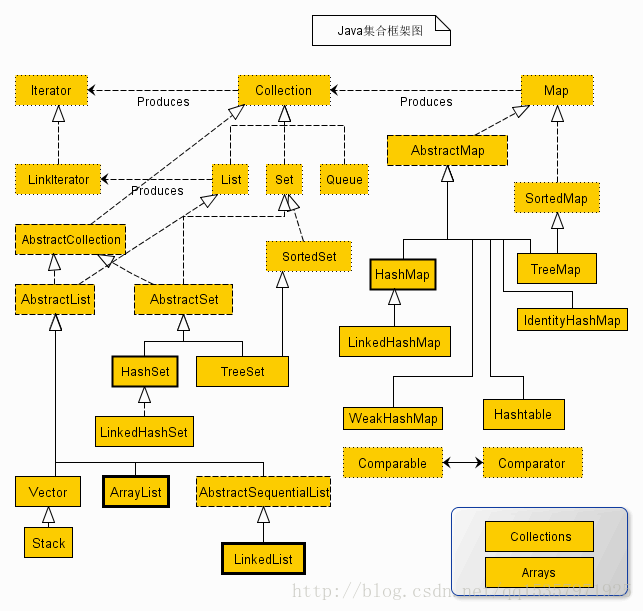Java集合分析(1):Iterator(迭代器)
集合框架在开发中经常用到,但一般情况下,我们只限于会用,却不知道其原理,用的过程会发生什么异常,我们也不知所然。所以我觉得花点时间研究研究集合框架还是很好的。
首先我们先看看集合框架的类图:
从上面的集合框架图可以看到,Java集合框架主要包括两种类型的容器:一种是Collection,另一种是Map,而 我们又能看到Collection 又继承了 Iterable< E > 接口,所以本节我们先学习下Iterable的用法以及原理。
Iterator(迭代器)
迭代器是一种设计模式,它是一个对象,它可以遍历并选择序列中的对象,而开发人员不需要了解该序列的底层结构。迭代器通常被称为“轻量级”对象,因为创建它的代价小。
这里要知道迭代器指向的位置是元素之前的位置,如下图所示:
当使用语句Iterator it=List.Iterator()时,迭代器it指向的位置是Iterator1指向的位置,当执行语句it.next()之后,迭代器指向的位置后移到Iterator2指向的位置。
Java中的Iterator功能比较简单,并且只能单向移动:
(1) 使用方法iterator()要求容器返回一个Iterator。第一次调用Iterator的next()方法时,它返回序列的第一个元素。注意:iterator()方法是java.lang.Iterable接口,被Collection继承。
(2) 使用next()获得序列中的下一个元素。
(3) 使用hasNext()检查序列中是否还有元素。
(4) 使用remove()将迭代器新返回的元素删除。
下面我们看这个例子:
import java.util.ArrayList;
import java.util.Iterator;
public class Test {
public static void main(String[] args) {
ArrayList list = new ArrayList();
list.add("a");
list.add("b");
list.add("c");
Iterator it = list.iterator();
while(it.hasNext()){
String content = (String) it.next();
System.out.println(content);
}
}
}
输出结果是:a b c
可以看到,Iterator通过next()遍历整个List,并取出存储的值。
但是,具体是怎么实现的呢?
这里我们来看看Java里ArrayList实现Iterator的部分源代码:
public class ArrayList<E> extends AbstractList<E>
implements List<E>, RandomAccess, Cloneable, java.io.Serializable
{
...
/**
* Appends the specified element to the end of this list.
*
* @param e element to be appended to this list
* @return true (as specified by {@link Collection#add})
*/
public boolean add(E e) {
ensureCapacityInternal(size + 1); // Increments modCount!!
elementData[size++] = e;
return true;
}
private void ensureCapacityInternal(int minCapacity) {
if (elementData == EMPTY_ELEMENTDATA) {
minCapacity = Math.max(DEFAULT_CAPACITY, minCapacity);
}
ensureExplicitCapacity(minCapacity);
}
private void ensureExplicitCapacity(int minCapacity) {
modCount++;
// overflow-conscious code
if (minCapacity - elementData.length > 0)
grow(minCapacity);
}
public E remove(int index) {
if (index >= size)
throw new IndexOutOfBoundsException(outOfBoundsMsg(index));
modCount++;
E oldValue = (E) elementData[index];
int numMoved = size - index - 1;
if (numMoved > 0)
System.arraycopy(elementData, index+1, elementData, index,
numMoved);
elementData[--size] = null; // clear to let GC do its work
return oldValue;
}
/**
* Removes all of the elements from this list. The list will
* be empty after this call returns.
*/
public void clear() {
modCount++;
// clear to let GC do its work
for (int i = 0; i < size; i++)
elementData[i] = null;
size = 0;
}
/**
* Returns an iterator over the elements in this list in proper sequence.
*
* The returned iterator is fail-fast.
*
* @return an iterator over the elements in this list in proper sequence
*/
public Iterator iterator() {
return new Itr();
}
/**
* An optimized version of AbstractList.Itr
*/
private class Itr implements Iterator<E> {
// The "limit" of this iterator. This is the size of the list at the time the
// iterator was created. Adding & removing elements will invalidate the iteration
// anyway (and cause next() to throw) so saving this value will guarantee that the
// value of hasNext() remains stable and won't flap between true and false when elements
// are added and removed from the list.
protected int limit = ArrayList.this.size;
int cursor; // index of next element to return
int lastRet = -1; // index of last element returned; -1 if no such
int expectedModCount = modCount;
public boolean hasNext() {
return cursor < limit;
}
@SuppressWarnings("unchecked")
public E next() {
if (modCount != expectedModCount)
throw new ConcurrentModificationException();
int i = cursor;
if (i >= limit)
throw new NoSuchElementException();
Object[] elementData = ArrayList.this.elementData;
if (i >= elementData.length)
throw new ConcurrentModificationException();
cursor = i + 1;
return (E) elementData[lastRet = i];
}
public void remove() {
if (lastRet < 0)
throw new IllegalStateException();
if (modCount != expectedModCount)
throw new ConcurrentModificationException();
try {
ArrayList.this.remove(lastRet);
cursor = lastRet;
lastRet = -1;
expectedModCount = modCount;
limit--;
} catch (IndexOutOfBoundsException ex) {
throw new ConcurrentModificationException();
}
}
@Override
@SuppressWarnings("unchecked")
public void forEachRemaining(Consumersuper E> consumer) {
Objects.requireNonNull(consumer);
final int size = ArrayList.this.size;
int i = cursor;
if (i >= size) {
return;
}
final Object[] elementData = ArrayList.this.elementData;
if (i >= elementData.length) {
throw new ConcurrentModificationException();
}
while (i != size && modCount == expectedModCount) {
consumer.accept((E) elementData[i++]);
}
// update once at end of iteration to reduce heap write traffic
cursor = i;
lastRet = i - 1;
if (modCount != expectedModCount)
throw new ConcurrentModificationException();
}
}
} 从上面源码可以看到,我们在调用迭代器的 next,remove 方法时,都会比较 expectedModCount 和 modCount 是否相等,如果不相等就会抛出 ConcurrentModificationException ,另外 modCount 在 add, clear, remove 时也都会被修改。
下面我们在第一个例子基础上添加一条语句:
import java.util.ArrayList;
import java.util.Iterator;
public class Test {
public static void main(String[] args) {
ArrayList list = new ArrayList();
list.add("a");
list.add("b");
list.add("c");
Iterator it = list.iterator();
while(it.hasNext()){
String content = (String) it.next();
System.out.println(content);
list.add("as");
}
}
} 我们可以看到程序抛出java.util.ConcurrentModificationException异常,而根据上面的分析,导致异常产生的原因很可能就是modCount 和 expectedModCount不相等导致的。这从而就产出了fail-fast机制。
fail-fast机制,它是Java集合的一种错误检测机制。当多个线程对集合进行结构上的改变的操作时,有可能会产生fail-fast机制。记住是有可能,而不是一定。
因此我们知道了 fail-fast 即 ConcurrentModificationException 出现的原因,怎么解决呢?
方案一:在遍历过程中所有涉及到改变modCount值得地方全部加上synchronized或者直接使用Collections.synchronizedList,这样就可以解决。但是不推荐,因为增删造成的同步锁可能会阻塞遍历操作。
方案二:使用CopyOnWriteArrayList来替换ArrayList。
CopyOnWriteArrayList所有可变操作(add、set 等等)都是通过对底层数组进行一次新的复制来实现的。
该类产生的开销比较大,但是在两种情况下,它非常适合使用。1:在不能或不想进行同步遍历,但又需要从并发线程中排除冲突时。2:当遍历操作的数量大大超过可变操作的数量时。
CopyOnWriterArrayList根本就不会产生ConcurrentModificationException异常,也就是它使用迭代器完全不会产生fail-fast机制。
public synchronized boolean add(E e) {
Object[] newElements = new Object[elements.length + 1];
System.arraycopy(elements, 0, newElements, 0, elements.length);
newElements[elements.length] = e;
elements = newElements;
return true;
}因为CopyOnWriterArrayList在写入时copy了原来的array,然后在这个 copy 的数组上进行add操作,这样就不会影响原来的迭代。不过这样造成的代价就是产生大量的对象,同时数组的copy也是相当有损耗的.
最后我们看看 Iterator 的使用:
其实上面列子已经给出了,
通常情况我们都会用for循环来遍历集合:
for(int i=0; i< ..;i++){
// ...
} 如果用Iterator 遍历集合:
Iterator iterator = list.iterator();
while (iterator.hasNext()){
System.out.println(iterator.next());
}参考:
http://www.cnblogs.com/hasse/p/5024193.html
http://www.cnblogs.com/pipi-style/p/4738099.html


